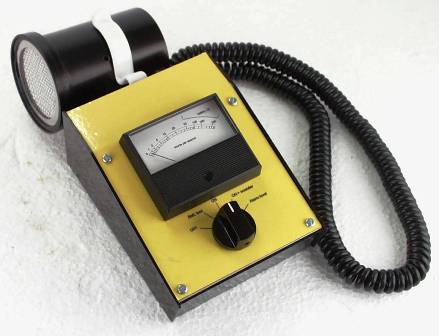Geiger Counter
This article is for general information only.
We no longer sell Geiger counters.
Please see www.distron.co.uk
Contents
Introduction
Testing Antiques for Radioactivity
Radioactivity - The Readings and the Hazards
Radioactivity and Testing Antiques
Introduction
Below is a non-technical article about Geiger Counters and their use in testing antiques. This article includes a layman's guide to 'safe' levels of radioactivity and (if you scroll to the bottom) a brief guide to how radiation is measured.
if you are buying on behalf of a hospital, laboratory, electronics company or government department, please skip this article and go straight to the technical data (pdf).

Testing Antiques for Radioactivity
This article published in the Antiques Trader Newspaper in 2003 (amended 2011)
The use of a Geiger counter is twofold. To find out if an item is hazardous irrespective of any antique value; and to find out if an item is genuine irrespective of any hazard.
Radioactivity - The Readings and the Hazards
| Reading | Hazard |
| 3 or 4 | Slightly above background level |
| 5 to 10 | Even at these low levels an item (e.g. watch) should not be kept next to skin for prolonged periods |
| 10 to 100 | Do not carry the item next to the skin at all |
| 100 to 200 | Do not to carry item close to your body, just handle it very occasionally |
| 200 to 500: | Best not to handle the item at all |
| 700 | Geiger counter overloads and gives continuous alarm - EXTREME CAUTION! |
I must stress that any reading above 2 c.p.s. indicates only an approximate and relative risk, there is no significance, for instance, in the reading being just below 200 or just above 200.
The above also gives you an idea of hazards involved in nuclear accident. For instance, you might hear that the level of radiation near the reactor is, "1000 times above background level" - that would be 1000 c.p.s.
An analogy (and just an analogy): you can feel a strong (hot) heat source on your skin, and the closer you get the hotter it feels, but as you move away the feeling of heat diminishes rapidly. The same applies to a radioactive source, a high reading against the source may frighten you, but now move the item away from the Geiger counter a few inches and the reading might drop to background level. Turn the item (e.g. a watch dial) upside down, is there a reading through the movement and back? If not, then no radioactivity will reach your skin through the back of the watch. Also, the human body varies in susceptibility, extremities (hands, fingers) are less at risk, the torso (chest, heart) is more at risk. Using the Geiger counter you can now make a decision: would you hang the watch around your neck with the dial facing your skin? Would you wear it on your wrist? Would you prefer to keep it in the back of a draw?
Radioactivity and Testing Antiques
Dials / Luminous Paint
I import goods from India, China, USA and Switzerland - and it was with surprise that I saw my Indian supplier advertising "Radium paint for watch dials". I asked them what it was made of and they said it was Radium. So I took a deep breath and ordered some. When it arrived I rushed it immediately to the laboratory where we tested it with our most sensitive equipment. It was not radioactive, not even slightly, it could not be Radium. But anyone presented with the tiny tube marked 'Radium paint' would have been very worried!
Vaseline (Uranium) Glass / Gemstones
Zircon is naturally radioactive, some gemstones are irradiated to change their colour. The Geiger Counter is not sensitive enough to detect these.



